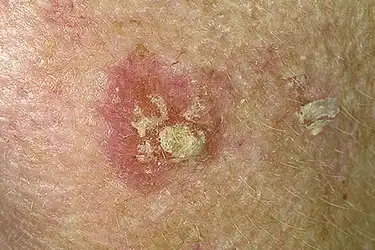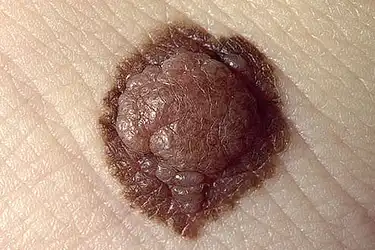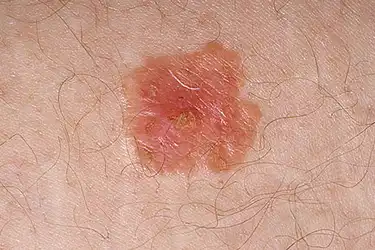What Does Skin Cancer Look Like On An Arm
Medically Reviewed by Debra Jaliman, Doc on August 20, 2020

Peel cancers -- including melanoma, basal prison cell carcinoma, and squamous prison cell carcinoma -- often start every bit changes to your skin. They can exist new growths or precancerous lesions -- changes that are not cancer but could become cancer over time. An estimated forty% to 50% of fair-skinned people who live to exist 65 will develop at least one peel cancer. Larn to spot the early on warning signs. Skin cancer tin be cured if information technology'due south found and treated early.

These small, scaly patches are acquired by too much sunday, and usually occur on the caput, neck, or easily, but can be plant elsewhere. They tin can be an early on alarm sign of skin cancer, but it's difficult to tell whether a particular patch volition continue to change over time and go cancerous. Most do not, but doctors recommend early treatment to forbid the evolution of squamous cell skin cancer. Fair-skinned, blond, or red-haired people with blueish or light-green eyes are most at risk.

Related to actinic keratosis, actinic cheilitis is a precancerous condition that usually appears on the lower lips. Scaly patches or persistent roughness of the lips may be present. Less mutual symptoms include swelling of the lip, loss of the sharp border between the lip and pare, and prominent lip lines. Actinic cheilitis may evolve into invasive squamous cell carcinoma if non treated.

The cutaneous horn appears equally a funnel-shaped growth that extends from a ruddy base of operations on the skin. Information technology is equanimous of compacted keratin (the same protein in nails). Information technology is a specialized type of actininc keratosis. The size and shape of the growth can vary considerably, but most are a few millimeters in length. Squamous cell carcinoma can be plant at the base of operations. It normally occurs in off-white-skinned elderly adults with a history of significant dominicus exposure.

A mole (nevus) is a benign growth of melanocytes, cells that gives skin its color. Although very few moles become cancer, abnormal or atypical moles can develop into melanoma over time. "Normal" moles tin can appear flat or raised or may begin flat and become raised over time. The surface is typically smooth. Moles that may have inverse into skin cancer are oft irregularly shaped, contain many colors, and are larger than the size of a pencil eraser. Most moles develop in youth or immature adulthood. It'south unusual to acquire a mole in the adult years.

Atypical moles are not cancer, but they can become cancer. They can exist found in sun-exposed or sun-protected areas of the trunk. Singular moles may exist larger (one-quarter inch beyond or larger) and more irregular in shape, with notched or fading borders. They may be flat or raised or the surface smooth or rough. They are typically of mixed color, including pink, reddish, tan, and brown.

About moles on a person'southward body look similar to one another. A mole or freckle that looks different from the others or that has any characteristics of the ABCDEs of melanoma should be checked by a dermatologist. It could be cancerous. The ABCDEs are important characteristics to consider when examining your moles or other skin growths, and then learn them in the slides to come.

Asymmetry means one half of a mole does not match the other one-half. Normal moles are symmetrical. When checking your moles or freckles, depict an imaginary line through the middle and compare the 2 halves. If they do not look the same on both sides, have information technology checked past a dermatologist.

If the border or edges of the mole are ragged, blurred, or irregular, have information technology checked by a dermatologist. Melanoma lesions often have uneven borders.

A mole that does not have the same color throughout or that has shades of tan, brown, black, blue, white, or red is suspicious. Normal moles are normally a single shade of color. A mole of many shades or that has lightened or darkened should be checked by a doctor.

A mole is suspicious if the diameter is larger than the eraser of a pencil.

A mole that is evolving – shrinking, growing larger, irresolute color, begins to itch or bleed – should be checked. If a portion of the mole appears newly elevated, or raised from the peel, have it looked at by a md. Melanoma lesions ofttimes grow in size or alter in superlative rapidly.

Examine your pare on a regular basis. A common location for melanoma in men is on the dorsum, and in women, the lower leg. But check your entire body for moles or suspicious spots once a month. First at your head and work your style down. Check the "subconscious" areas: betwixt fingers and toes, the groin, soles of the feet, the backs of the knees. Cheque your scalp and neck for moles. Utilize a handheld mirror or inquire a family fellow member to help you look at these areas. Be particularly suspicious of a new mole. Have a photograph of moles and date information technology to help you monitor them for change. Pay special attending to moles if you're a teen, pregnant, or going through menopause, times when your hormones may be surging.

If y'all find a mole or spot that has whatever ABCDE's of melanoma -- or ane that'south tender, itching, oozing, scaly, doesn't heal or has redness or swelling beyond the mole -- come across a doctor. Your doctor may want to remove a tissue sample from the mole and biopsy it. If constitute to be cancerous, the entire mole and a rim of normal pare around it will be removed and the wound stitched closed. Additional treatment may be needed.

Cancerous melanoma, especially in the later stages, is serious and treatment is difficult. Early diagnosis and handling can increment the survival rate. Nonmelanoma skin cancers include basal jail cell carcinoma and squamous cell carcinoma. Both are common and are most always cured when found early and treated. People who've had skin cancer in one case are at chance for getting it again; they should go a checkup at least once a twelvemonth.

Melanoma is not equally common as other types of skin cancer, but it'southward the most serious and potentially mortiferous. Possible signs of melanoma include a alter in the appearance of a mole or pigmented area. Consult a doctor if a mole changes in size, shape, or colour, has irregular edges, is more than than ane color, is asymmetrical, or itches, oozes, or bleeds.

This nonmelanoma skin cancer may appear as a business firm red nodule, a scaly growth that bleeds or develops a crust, or a sore that doesn't heal. It most often occurs on the nose, brow, ears, lower lip, hands, and other sun-exposed areas of the body. Squamous cell carcinoma is curable if caught and treated early on. If the pare cancer becomes more advanced, treatment volition depend on the stage of cancer.

Bowen disease is also called squamous jail cell carcinoma "in situ." It is a type of skin cancer that spreads outward on the surface of the pare. By contrast, "invasive" squamous cell carcinomas can grow inward and spread to the interior of the body. Bowen disease looks like scaly, ruby patches that may exist crusted; it may be mistaken for rashes, eczema, fungus, or psoriasis.

Basal prison cell carcinoma is the most common and easiest-to-care for skin cancer. Considering basal cell carcinoma spreads slowly, it occurs mostly in adults. Basal cell tumors can take on many forms, including a pearly white or waxy bump, frequently with visible blood vessels, on the ears, neck, or face. Tumors can likewise announced as a flat, scaly, flesh-colored or brown patch on the back or chest, or more rarely, a white, waxy scar.

Uncommon types of skin cancer include Kaposi'due south sarcoma, mainly seen in people with weakened allowed systems; sebaceous gland carcinoma, an aggressive cancer originating in the oil glands in the skin; and Merkel cell carcinoma, which is usually found on sun-exposed areas on the head, neck, arms, and legs but often spreads to other parts of the body.

Sun exposure is the biggest cause of peel cancer. But it doesn't explicate skin cancers that develop on skin not ordinarily exposed to sunlight. Exposure to environmental hazards, radiations handling, and even heredity may play a role. Although anyone can get skin cancer, the risk is greatest for people who have:
- Off-white peel or light-colored eyes
- An abundance of large and irregularly-shaped moles
- A family history of skin cancer
- A history of excessive sun exposure or blistering sunburns
- Lived at high altitudes or with year-round sunshine
- Received radiation treatments

Limit your exposure to the sun's ultraviolet rays, especially between x a.yard. and 4 p.m., when the sun's rays are strongest. While outdoors, liberally utilise a broad spectrum sunscreen with an SPF of 30 or higher (don't forget the lips and ears!), article of clothing a hat and sunglasses, and encompass upwardly with clothing. And remember, if you notice changes to your skin such equally a new growth, a mole changing appearance, or a sore that won't heal, see a doc correct way.
Source: https://www.webmd.com/melanoma-skin-cancer/ss/skin-cancer-and-skin-lesions-overview
Posted by: brownagerelf.blogspot.com







0 Response to "What Does Skin Cancer Look Like On An Arm"
Post a Comment